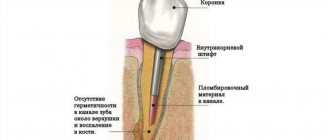How is autotransplantation better than titanium implants?
The advantages of autotransplantation, accordingly, firstly, are that your tooth, which is the wisdom tooth, most often they are located so far away and it is impossible to use them - anyway, we give it a second chance, so you can use it all your life.
Also, the tooth you are transplanting has a ligamentous apparatus and this is the only thing that cannot be imitated by any implants. There is a bunch of teeth
and, accordingly, it contributes to the fact that it takes root, it promotes blood supply to bone tissue, even in cases where there is a deficiency of bone tissue.
And, let’s say the tooth that is being removed has bone tissue destroyed on either side, if you transplant your wisdom tooth with a ligamentous apparatus, this ligamentous apparatus will restore this bone tissue. She should recover completely, that is, it’s such a miracle
.
Indications for use
Autologous tooth transplantation may be necessary in the following cases:
- tooth loss due to injury;
- the need for removal due to widespread caries (deep type);
- congenital absence of a tooth when there was no germ;
- removal is done for orthodontic purposes, since the tooth affects the malocclusion.
You can find cases of transplanting your own tooth in childhood or adolescence. This is due to the fact that implantation is contraindicated before the age of 18, since the jaw bones are growing and are not yet fully formed. And the survival rate of your own tooth is almost the same as that of an implant, and with a good outcome of the operation, it will grow and develop along with its owner. The work of the orthopedist will move the teeth so that the empty space of the taken donor will not be noticeable.
Contraindications for carrying out
First of all, a young patient must be psychologically ready for autotransplantation; it is much easier for adults to take this step. The procedure cannot be performed if:
- there is not enough space between adjacent teeth to restore the void with a dental graft;
- bone diseases can interfere with survival;
- local inflammation in the oral cavity;
- psychological diseases;
- autoimmune diseases, diabetes, cardiovascular problems,
- poor oral hygiene.
Minuses
- Transplantation of your own tooth has many restrictions: the tooth must meet all parameters and be healthy.
- After transplanting the formed tooth, endodontic treatment is carried out - the nerve (pulp) is removed and the canals are filled.
- If a lot of time has passed since the loss of the tooth, bone grafting (bone grafting) is needed. While more and more implantations are carried out without it.
- The operation is rare, and few doctors have sufficient experience. It is easy to gain experience in implantation; operations are performed every day. Wisdom tooth transplantation is a rare event. Transplantation of impacted and “extra” teeth is generally a rare occurrence, especially in small dentistry.
How it is carried out: stages of treatment
Autotransplantation requires a tooth with healthy characteristics. For these purposes, a rudiment with a dental follicle, which contains cells ready for growth and development of the root system, works very well. Wisdom teeth are taken to replace 6 and 7; if the front tooth is injured, then any suitable 4.5 can be taken. Often, for upper losses, the donor is the lower teeth, because the lower tissues are restored well.
- Diagnostics. X-rays and CT scans are used to evaluate the condition of the jaw bone and tooth roots;
- Creation of a computer model of the donor tooth. It is printed on a 3D printer based on CT data;
- Extraction of an infected or decayed tooth;
- Treatment of the hole with an antiseptic and antibiotic. If the place has been empty for a long time, the hole is formed surgically;
- Trying on a 3D model of the tooth so that the shape of the hole for the roots fits perfectly;
- Removal of a healthy tooth or germ. One of the important points is to preserve the ligamentous apparatus. The success of donor integration depends on its viability;
- Transplantation of the removed tooth to a prepared site. The time between extraction and installation should be no more than 25 minutes for the donor tissue to function normally;
- Splinting and suturing.
After a few days, the sutures are removed, and after 25 days, the splints are removed. Then the orthopedic correction begins.
Dental transplantation: pros and cons
Although, at first glance, this technique has many advantages, there is no consensus on this issue in dentistry. The advantages of transplantation include the return of normal chewing of food, prevention of the development of bite defects, and restoration of the beauty of the smile. The key point is that these operations can be performed on children and adolescents who are contraindicated for implantation.
However, there are a number of features pointed out by doctors who are not entirely positive about this technique:
- there is a risk of tooth rejection - this happens in 5-20% of cases;
- in some patients, the roots of transplanted teeth resolve within 2-3 years;
- if the roots of the transplanted teeth fuse with the jaw directly, and not through the periodontal ligament, they will begin to deteriorate quite quickly;
- since wisdom teeth have a very branched root system, additional traumatic manipulations are required to engraft them in place of chewing teeth;
- the need for orthodontic correction.
It is worth noting that the success of engraftment is influenced by the patient’s age and the type of transplant - the follicle engrafts more successfully than an already formed tooth. However, transplants are successful in 80-95% of cases.
Expert opinion
Igor Yurievich Malinovsky
Maxillofacial surgeon, implantologist
Experience: more than 11 years
Transplanting teeth from one area to another is not widespread. The risks of complications are quite high; the tooth may not take root. And it is morally difficult for the patient to experience psychological stress again. Especially considering that these are often children - teenagers, boys and girls. Among dentists there is no clear opinion on this method of restoration. And I am also inclined towards temporary prosthetics, until the time when it will be possible to put reliable and comfortable crowns on the implants. Of course, it is worth mentioning that autologous dental transplantation should not even be considered for older patients.
What is autologous dental transplantation?
This is a unique surgical operation performed by doctors at our clinic.
Autotransplantation is a procedure in which a healthy tooth is taken from a patient from an area where it is less functional (wisdom tooth, supernumerary tooth). This tooth becomes a donor. It is transplanted to a place where there is a great need for it - if tooth extraction is required (severely damaged tooth, root crack, etc.). That is, autotransplantation is an alternative to traditional implantation. Instead of implanting an implant, your own natural tooth is implanted.
Attention: such a transplant is not possible in all cases; the indications will be determined at a personal appointment and after diagnosis.
Direction: Surgery and implantation
0/0
Autotransplantation is the transplantation of your own tooth. Photo before deletion
After treatment. We implanted a wisdom tooth in place of the extracted tooth.
Doctor: Shirnaliev Ulvi
Direction: Surgery and implantation
0/0
Autotransplantation is the transplantation of your own tooth. Photo before treatment.
A root crack was diagnosed and the tooth was removed.
We implanted a wisdom tooth in place of the extracted tooth.
Doctors: Unzhakova Yulia Kobozev Mikhail
Direction: Surgery and implantation
0/0
Autotransplantation is the transplantation of your own tooth. Before treatment (cracked root of the sixth tooth).
Tooth removed, fitting of wisdom tooth template.
We implanted a figure eight in place of the extracted tooth.
New tooth - after endodontics.
Doctors: Unzhakova Yulia Kobozev Mikhail
How much does a tooth transplant cost?
Each dental clinic sets its own prices for autotransplantation. And the price depends on the status of the center, the qualifications of the doctor, the complexity of the operation: whether the removal will take place during the operation or whether the work will take place in an already empty place, the anterior or chewing units will be replaced. But on average, transplanting your own tooth will cost from 25,000 to 45,000 rubles.
It seems that transplanting your own organ to yourself is much cheaper. Since there are no costs for expensive materials: implant, abutment and crown, or the work of a dental technician. “Everything is yours” as they say. But the price is not much lower than implantation.
Should wisdom teeth be preserved?
We think yes.
Although wisdom teeth are not involved in the process of chewing food, they can still benefit a person. There must be clear medical indications for their removal. And now we will provide you with another proof of the benefits of your own teeth-eights. Our patient Kim is about 20 years old, she is from Korea and lives in Moscow, as her parents work at the Korean embassy. I contacted the German Implantology Center due to inflammation of tooth 4.6 – the lower right six. The tooth was destroyed
, an abscess developed. There was a temporary filling on the tooth (placed in another clinic):
Where a temporary filling was placed, she was told to remove the tooth. That's why Kim came to us with one simple goal - to atraumatically remove the six, which began to greatly bother and hurt her. After doing a CT scan and looking at the tooth, we offered her an option, which, upon hearing, Kim at first did not believe her ears. Our proposal was to remove the six and immediately in its place... transplant its lower right wisdom tooth! This is called autotransplantation surgery.
What are the alternatives?
Instead of autotransplantation in dentistry, there is a choice - implantation or prosthetics.
Implantation allows you to install an artificial root into the hole and load it with a prosthesis, a crown. The implant is made of titanium alloy and has a surface treated in a special way, which allows it to take root with 99% success. The manufacturer provides a lifetime warranty on many implants.
Prosthetics will help hide the empty space using an orthopedic design. The bridge will be supported by supporting teeth and perform an aesthetic function.
Stages of transplantation
The procedure is carried out in several stages:
- Diagnosis based on X-rays and computed tomography.
- Removal of a damaged tooth.
- Treatment of the transplant site with a special antiseptic composition.
- Extraction of a germ or tooth for transplantation.
- Implantation into a prepared place.
- Placing a splint for fixation.
- Stitching.
The splints are removed after approximately 20-30 days. This is the optimal period for tooth adaptation. Using this technology, you can completely restore a healthy tooth and prevent malocclusion.










